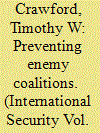|
|
|
Sort Order |
|
|
|
Items / Page
|
|
|
|
|
|
|
| Srl | Item |
| 1 |
ID:
175846


|
|
|
|
|
| Summary/Abstract |
A wedge strategy is a state’s attempt to prevent, break up, or weaken a threatening or blocking alliance. An asymmetric alignment consists of a great power (the alignment leader) and a small/middle power (the weaker ally). So when does the wedge strategy of a great power (a divider) towards a competitive asymmetric alignment work? I propose, based upon the ‘Crawford–Izumikawa debate’, an ‘interdependence theory’ of wedge strategies. In the case of an asymmetric alignment that is symmetrically interdependent, the wedge strategy of a divider that accommodates the weaker ally is most likely to succeed. However, a wedge strategy towards an asymmetric alignment that is asymmetrically interdependent is highly likely to fail. I evaluate the theory based upon four wedge strategies adopted in Cold War Asia through analysing American, Russian, and Chinese archival sources. As asymmetrically interdependent, the US–Japan and US–Taiwan alliances offset the impact of Chinese wedge strategies. Between 1955 and 1965, therefore, neither Chinese accommodation nor Chinese pressure could detach weaker American allies from the United States in East Asia. However, China successfully exploited the symmetric interdependence of the US–Pakistan alliance. Between 1962 and 1965, China’s accommodation of Pakistan prevented Pakistan from being used as an American base for containment purposes. Likewise, the Soviet Union took full advantage of the Sino–Vietnamese alignment’s symmetric interdependence, whereby Soviet aid to North Vietnam caused rifts in Sino–Vietnamese relations that eventually wrecked the Sino–Vietnamese alignment. According to the theory, therefore, given the asymmetric interdependence of the hub-and-spokes system, any Chinese attempts to weaken US-sponsored alliances in East Asia would not be effective.
|
|
|
|
|
|
|
|
|
|
|
|
|
|
|
|
| 2 |
ID:
103656


|
|
|
|
|
| Publication |
2011.
|
| Summary/Abstract |
States use wedge strategies to prevent hostile alliances from forming or to disperse those that have formed. These strategies can cause power alignments that are otherwise unlikely to occur, and thus have significant consequences for international politics. How do such strategies work and what conditions promote their success? The wedge strategies that are likely to have significant effects use selective accommodation-concessions, compensations, and other inducements-to detach and neutralize potential adversaries. These kinds of strategies play important roles in the statecraft of both defensive and offensive powers. Defenders use selective accommodation to balance against a primary threat by neutralizing lesser ones that might ally with it. Expansionists use selective accommodation to prevent or break up blocking coalitions, which isolates opposing states by inducing potential balancers to buck-pass, bandwagon, or hide. Two cases-Great Britain's defensive attempts to accommodate Italy in the late 1930s and Germany's offensive efforts to accommodate the Soviet Union in 1939-help to demonstrate these arguments. By paying attention to these dynamics, international relations scholars can better understand how balancing works in specific cases, how it manifests more broadly in international politics, and why it sometimes fails in situations where it ought to work well.
|
|
|
|
|
|
|
|
|
|
|
|
|
|
|
|
| 3 |
ID:
189253


|
|
|
|
|
| Summary/Abstract |
This article analyses wedge strategies in the context of Russo-Japanese relations. In particular, it looks at how both countries have sought to generate a dis-alignment in the opposing side, preventing further steps toward the consolidation of potentially threatening partnerships: the US-Japan alliance for Russia, and the Russia-China entente for Japan. After identifying the respective goals of Russia and Japan, the article examines the conditions that enable the success of wedge strategies. Looking at the case of Russia-Japan relations from 2012 to 2020, the article argues that a strategy constituted of a mix of positive economic and political incentives and a limited amount of coercion can succeed in producing a degree of dis-alignment in the opposing camp. Russia’s strategy seems to be more productive than Japan’s since Moscow has managed to minimize the effect of sanctions imposed by Japan and it has reduced political differences to mostly bilateral and regional issues. A greater level of cooperation with established partners for both Russia and Japan, and limited costs of wedging strategies, have resulted in dis-alignment but not a reversal of existing alignments. The article also indicates that in this case credibility issues do not fundamentally affect the degree of success of wedge strategies.
|
|
|
|
|
|
|
|
|
|
|
|
|
|
|
|
|
|
|
|
|